advertisement
Natural Eating Isn’t Just For Humans—Here’s What You Should Feed Your Dog, According to a Vet Nutritionist
Veterinarian Susan Wynn delves into the ins and outs of feeding your dog raw pet food, and what to look for the next time you go shopping.

How would you feel if you sat down for a virtual Saturday night dinner party, but instead of the delicious, Food Network-level meal the rest of your friends dive mouth-first into, you’re greeted with a freezer-burned TV dinner? File that under dinner-party #fail.
But for many four-legged friends, that’s reality. Day after day, pups are subjected to subpar meals, while they watch their owners dig into a delicious, health-boosting dish du jour. What gives?
Here’s what: “The pet food industry as we know it was born in the early part of the 20th century as a new industry to make use of by-products from the production of food for people,” says Susan G. Wynn, DVM, DACVN, and senior director of scientific affairs for Instinct® Pet Food. In other words, pet food was made from the scraps.
According to Dr. Wynn, that all changed when veterinarians and pet owners started experimenting with raw feeding after medical treatments had failed for their dogs with chronic ear, skin, and stomach issues. And bam: no more skin, ear, or stomach issues.
Yep, putting pets on a raw diet helped clear up the issues that seemed to be brought on by low-quality kibble. “Many diet ‘trends’ like this gain transient popularity but die away, because they don’t truly work or have a scientific basis,” Dr. Wynn says. “But raw feeding has grown, in the face of resistance by the pet food and veterinary industries. Raw feeding seems to work.”
Those results are why Instinct® uses whole, real ingredients in all of its frozen recipes—varying from chicken to beef to even duck—all of which undergo complex formulating and testing that can take up to months at a time. Respect to raw.
Keep scrolling for more benefits of feeding your dog raw pet food, and what to look for the next time you go shopping.
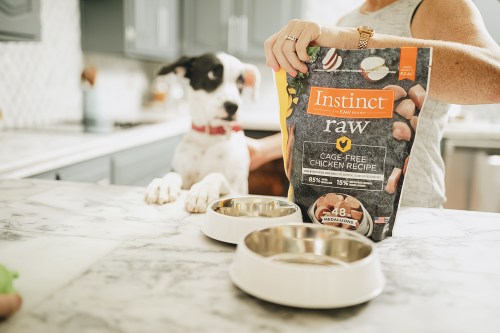
What to look for in dog food
While you might be well-versed in reading human foods’ nutrition info, pet food labels are a bit different. For one, the ingredient list isn’t the most important thing on the packaging, Dr. Wynn says. “Pet food labels are designed by law to not be misleading—in other words, the packaging on pet foods is meant to protect consumers from fraud rather than really reveal much about the food,” she says. (Scratching your head yet?)
Luckily, Dr. Wynn, who’s experienced in pet food formulation, has some tips for how to pinpoint high-quality food. “When I was in practice, I told pet owners not to choose a food—choose a company,” she shares. “Learn about what the different companies do to ensure that their formulations are complete and balanced, how they test to make sure that their ingredients are consistent and their finished products contain the nutrients that they think are supposed to be there.”
Before aligning with a brand you trust, Dr. Wynn says there are some questions to run by your vet or research for yourself before making a purchase, like: Do you employ a PhD animal nutritionist or a board-certified veterinary nutritionist? Who formulates your foods? Are your diets tested using feeding trial? What quality control measures do you use? These are only four of the nine questions the World Small Animal Veterinary Association recommends you ask before settling with a specific food brand.
Instinct® already checks off on all of these inquiries, and then some. “Our formulators and scientists have PhDs and masters degrees in food technology and animal science, and they have worked for some of the largest human baby food as well as pet food companies in the U.S.,” Dr. Wynn says. Plus, there is zero tolerance for pathogens. In fact, the pinnacle of Instinct®’s raw products—Instinct® Raw Signature—is tested multiple times and supported by feeding trials before hitting the shelf. (Check, check, and check.)
LEARN MORE

Instinct Raw Real Beef Recipe
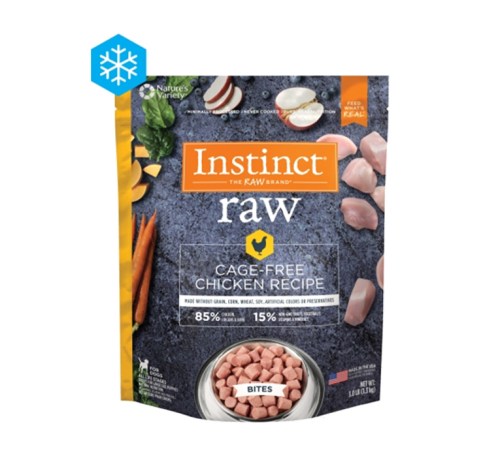
Instinct Raw Cage-free Chicken Recipe
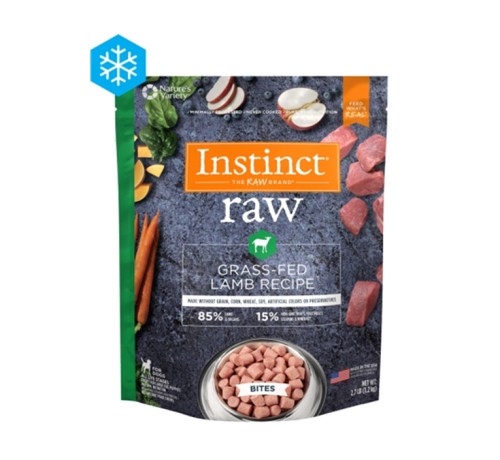
Instinct Raw Grass-fed Lamb Recipe
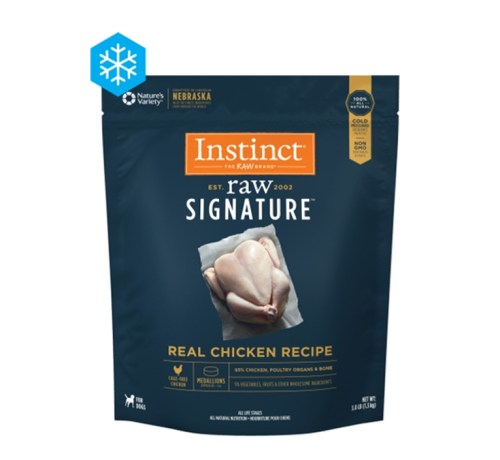
Instinct Raw Signature Cage-free Chicken Recipe

Instinct Raw Signature Cage-free Duck Recipe
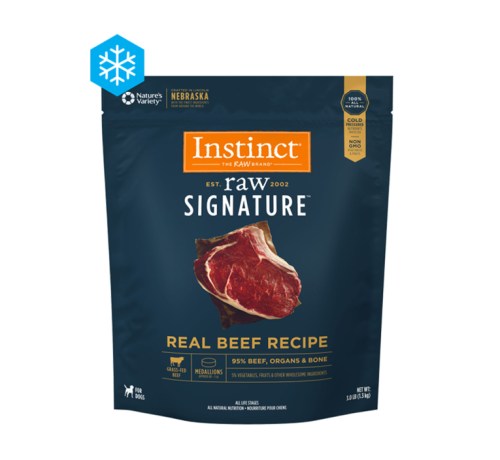
Instinct Raw Signature Grass-fed Beef Recipe
Why it matters
You already know from earlier that switching dogs to a raw diet helped clear up some skin, ear, and stomach issues. Feeding your dog more nutrient-dense food is also associated with a lower chance of developing allergies and arthritis later in life, she says. How does raw food have such magic? According to Dr. Wynn, it’s thanks to two giant biochemical differences from cooked or processed food.
“First, it retains nutrients and other natural compounds that would be destroyed in kibble, canned, or dehydrated foods,” she says. “This means that raw food is much more biochemically complex—it is diverse and contains more biologically functional compounds (i.e. nutrients) than processed food.”
The second difference is that raw food contains no cooking toxins, which form when heat links a protein and a sugar in the food, says Dr. Wynn. “These MRPs (scientific name for cooking toxins) are also thought to cause inflammation and degeneration of tissues, possibly worsening allergies, arthritis, and other conditions associated with aging.” So the next time you throw a virtual dinner party, make sure you include a raw-only plate for your pup, too.
Sponsored by Instinct® Pet Food
Top photo: Getty Images/Isadora Romero
Sign Up for Our Daily Newsletter
Get all the latest in wellness, trends, food, fitness, beauty, and more delivered right to your inbox.
Got it, you've been added to our email list.




